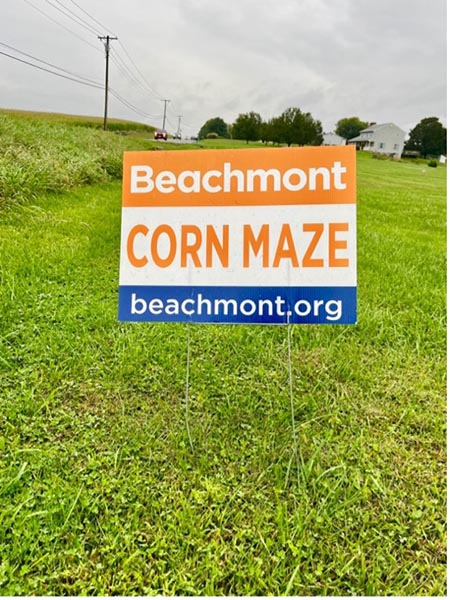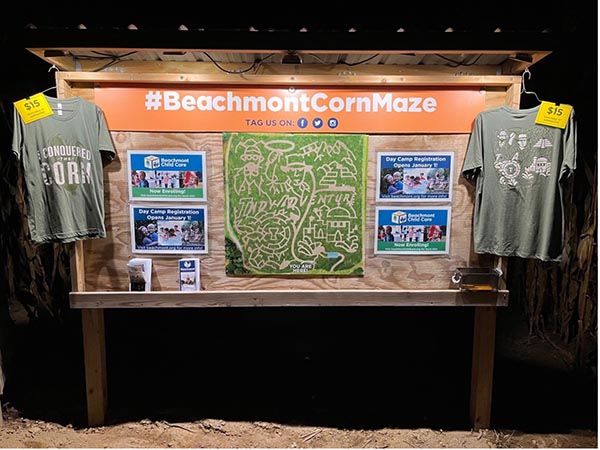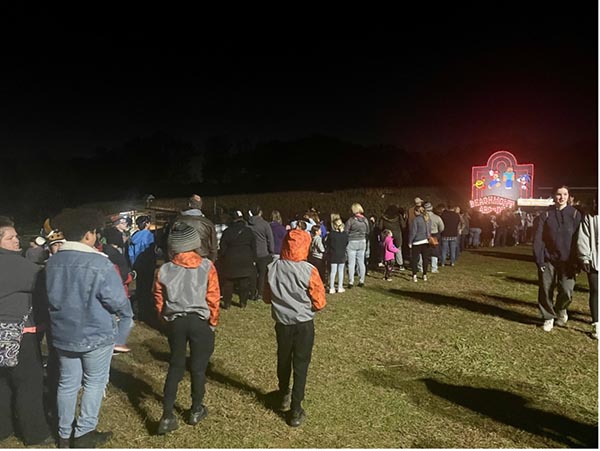As printers watch certain categories of print business disappear, diversification helps to maintain share of customer. Take the example of Beachmont Christian Ministries, a nonprofit in Kingsville, MD that has been serving its local communities for 50 years with a variety of programs, including summer camp, sports programs, and a large corn maze.
When Stewart Walker came on board as executive director, the organization was printing 10,000 brochures every year. The brochures were designed to promote the corn maze, which at the time was drawing 10,000 – 14,000 visitors every year. Brochures were distributed to local schools and businesses, which, along with billboards and participation in the local Fourth of July parade, were the primary method of promotion.
Walker looked at the primary audience for the maze, which is young families, however, and asked, “Who makes most of the decisions around family activities?” The answer, of course, is moms. Where do moms get their information? Social media. So over the next few years under Walker’s leadership, the number of corn maze brochures dropped from 10,000, to 5,000, to zero, while Beachmont built up its social media presence.
“For significantly less money, we can use social media to reach a greater number of people faster and with real time updates,” says Walkers. “Initially, we were using the brochures to cast a wide net and build up knowledge of this event. Now that’s been accomplished, it’s a strategy we don’t need to utilize anymore.”
Does this mean that Beachmont isn’t using print? Not at all. Walker recognizes a key truth about print—that it works in concert with digital channels like email and social media.
From Brochures to Road Signs
After Beachmont established a robust social media program on Facebook and Instagram, Walker engaged with a local sign company to produce 18” x 24” double-sided yard signs. He started out “conservatively” with 20 signs, which the team placed at key intersections (with the property owner’s permission) around the county. This year, he added 40 additional signs.

“If someone is driving back and forth on the same route, morning and evening, day after day, and they see a sign that is well done, it will stick in their head,” Walker explains. “We stick with minimal information, high contrast, high resolution, and eye-catching color. It’s proven to be very effective.”
Beachmont has also invested in billboards at key locations, as well as in radio advertising.
Blending print and social media, Walker also made an adjustment to the exit of the corn maze. Previously, the exit board thanked visitors and gave them an opportunity to sign a white board saying they’d completed the quest. But Walker had a better idea. Every year, the corn maze has a different theme, and the theme is incorporated into the design of the maze. He directed the team to start using a drone to take aerial pictures of the maze, a picture that is then placed at the exit underneath a large, branded banner with the hashtag #beachmontcornmaze. Now, when people stop to take pictures at the exit in front of the sign, the hashtag is right above it.

Because Walker is also a huge fan of guest experience, he has also invested heavily in way finding signage. Everything at the maze, from the entrance and exit, to locations of concessions and restrooms, to party rooms and the hayride, is marked in bright, clear, contrasting brand colors.
An equal fan of cross-promotion, Walker ensured that posters cross-promoting other programs are prominently displayed in identified high-traffic areas, such as admissions, concessions, the exit, and in the eating area.
A Listening Ear to Marketing Needs
Also new since Walker’s arrival is staffing the exit with enthusiastic representatives of the nonprofit, who greet visitors as they exit the maze, engage them about their experience and ask how they heard about the maze. “Consistently, every year, it’s a mix of things,” says Walker. “They saw a yard sign. They saw a billboard or heard a radio ad. They found us on social media, or a friend shared a post. It’s never heavily weighted toward one channel or another. It’s always a mix of all of the types of promotion that we do.”
The impact of the introduction of these new channels? Visitors to the corn maze now reach between 22,000 - 23,000 people each year.

Also learned as a result of manning the exit is the number of people who know Beachmont for its corn maze but who are unfamiliar with its many other programs. So brochures came back. In smaller numbers, and not for the corn maze, but for Beachmont itself.
At the exit of the corn maze are now brochures promoting Beachmont’s full range of programs, as well as a separate set of brochures promoting its new childcare program. The 8 ½” x 11” trifolds are paired with QR codes that take corn maze visitors to the website. “Now that the ability to read QR codes is built into the browsers of people’s cellphones, QR codes have become highly effective for us,” says Walker.
At Beachmont, QR codes are everywhere. They are posted on 11” x 17” signs in six strategic locations around the campus. This includes when people are walking up in the admissions line. “Sometimes visitors are in that line for 15 to 20 minutes,” says Walker. “They are all also at these pinch points – waiting for a hayride, waiting for food at the concessions stand, or under the pavilion, eating. All of those locations have signs with QR codes on them.”
All of the banners, from the front entrance to the exit and everywhere in-between, everything is simple, high-contrast, and branded.
Let’s Hear It for Swag!
Even as Beachmont has invested heavily in print, its needs are growing. One of its major fundraisers is the organization’s annual golf tournament, which raises funds to scholarship camp registrations for under-privileged children. For that event, Beachmont invests in a wide range of printed products, as well. This includes event and sponsor banners, table tents, and brochures.
For the event, Beachmont also invests in a wide variety of promotional items such as t-shirts, decals, magnets, wristbands, and branded swag used as giveaways during the event and that turn into walking advertisements for Beachmont afterwards.
Beachmont has also added branded t-shirts for sale during the corn maze. While revenue is not the primary goal, the t-shirts do make a profit, but more importantly for Walker, however, it’s another form of walking advertising that works together with all of the other promotional efforts so that, in the surrounding counties, Beachmont is everywhere.
Beachmont is also investing heavily in print. It just looks different than it used to. Consider the organization’s marketing evolution:
Pre-10,000 Brochures
- Brochures
- Website
- Billboards
Post-10,000 Brochures
- Brochures
- Banners
- Posters
- Website
- Yard signs
- Billboards
- Social media
- Radio spots
- Branded t-shirts and hoodies
- Magnets and decals
- Wristbands
- Blankets
- Table Tents
So while its brochures were first phased out (then brought back at a more minimal level), its overall print needs have grown. This growth has been fueled by an understanding of the importance of saturating a wide variety of channels, combined with providing an outstanding guest experience facilitated by clear, well-placed wayfinding signage and banners and cross-promotional communications.
So even with the drastic reduction in the number of printed brochures, print is clearly alive and well at this nonprofit.















Discussion
Only verified members can comment.